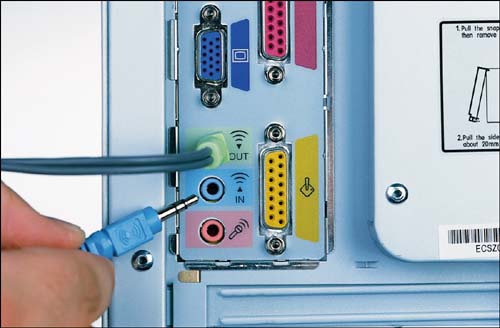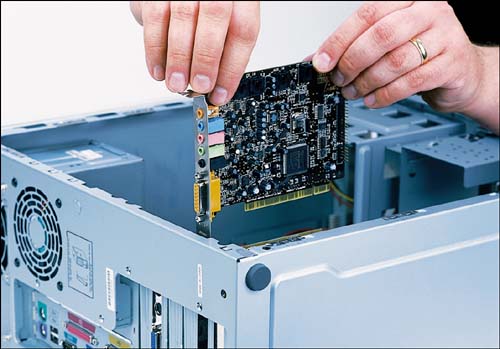Upgrade #2: Replacing Your Sound Card After you've decided on what type of new sound card to buy, it's time to install it. You install a sound card the same way you install any other expansion board open up your system's case and slide the card into an open slot. The only thing to watch out for is any internal cables attached to your card, typically connected to your CD/DVD drive. You'll need to disconnect the cables from your old card and reconnect them to your new one. You also need to determine whether your PC currently uses a removable sound card or whether it incorporates its audio functions on the motherboard. This is easy enough to see after you get the case off the system unit; a separate sound card will be installed in a normal expansion slot. Look for the audio connections on the back of your PC, and if they don't lead to a removable card if they're hardwired to some spot on the motherboard you don't have an existing sound card to remove. If this describes your system, skip ahead to the "Upgrading from Motherboard Audio" section before you attempt to install your new card. Installing the Card To install an internal sound card, follow these instructions: From within Windows, open the Control Panel and select Performance and Maintenance, and then System. When the System Properties dialog box appears, select the Hardware tab and click the Device Manager button to open the Device Manager. From the Device Manager, click the Sound, Video, and Game Controllers item, select your current sound card, and click the Uninstall button (or select Action, Uninstall). Close Windows and power off your system. Disconnect your PC from its power source. Disconnect any cables currently connected to your sound card, such as speaker, headphone, or microphone cables. Open the system unit case. Locate your existing sound card. (If your PC has the audio integrated onto the motherboard, there won't be a separate sound card; in this instance, skip ahead to step 11.) Remove the screw (on the back of the system unit) holding the old sound card in place. Save the screw you'll need to use it again. If there are any cables running to the sound card from other devices (such as your CD/DVD drive), label them with masking tape or a sticker, and then disconnect them. Remove the old sound card from its slot and set it aside. Insert the new sound card into the now-open slot (see Figure 10.4). Figure 10.4. Holding the card by the edges, carefully insert it into the slot and press firmly to seat it. 
Reconnect any cables you disconnected previously (in step 9). See Figure 10.5. Figure 10.5. Reconnect all the internal cables fortunately, most newer PCs use color-coded cables. 
Use the screw you saved in step 8 to fasten the new card into place. Reattach the cable that connects your speakers to the new sound card. While you're at it, reconnect any other cables you disconnected back in step 5. Reinstall the system unit cover and reconnect the PC to its power source; while you're at it, go ahead and plug your monitor back in, too. Restart your computer. Run the installation software that came with your new sound card, or use the Windows Add Hardware Wizard to install the proper drivers for the new card.
Upgrading from Motherboard Audio If your computer system doesn't have an existing sound card, that means that the audio is built into the motherboard. If this describes your system, not only do you have to disregard steps 7 through 10 in the previous section, but you also have to disable your onboard audio. You should do this before you install your new sound card. Here's what you need to do: Shut down and restart your computer. While your computer is booting up, press the appropriate key to enter the BIOS setup utility. Navigate to the setup page used to configure your system's built-in audio. (This varies from system to system; it might be the I/O Device Configuration page, or something similar.) Find the settings for audio, legacy audio, game port, MIDI, and SB (Sound Blaster) devices. Disable these devices. Save the changes and restart your system.
With these changes you made, you can then proceed to install your new audio card. |

